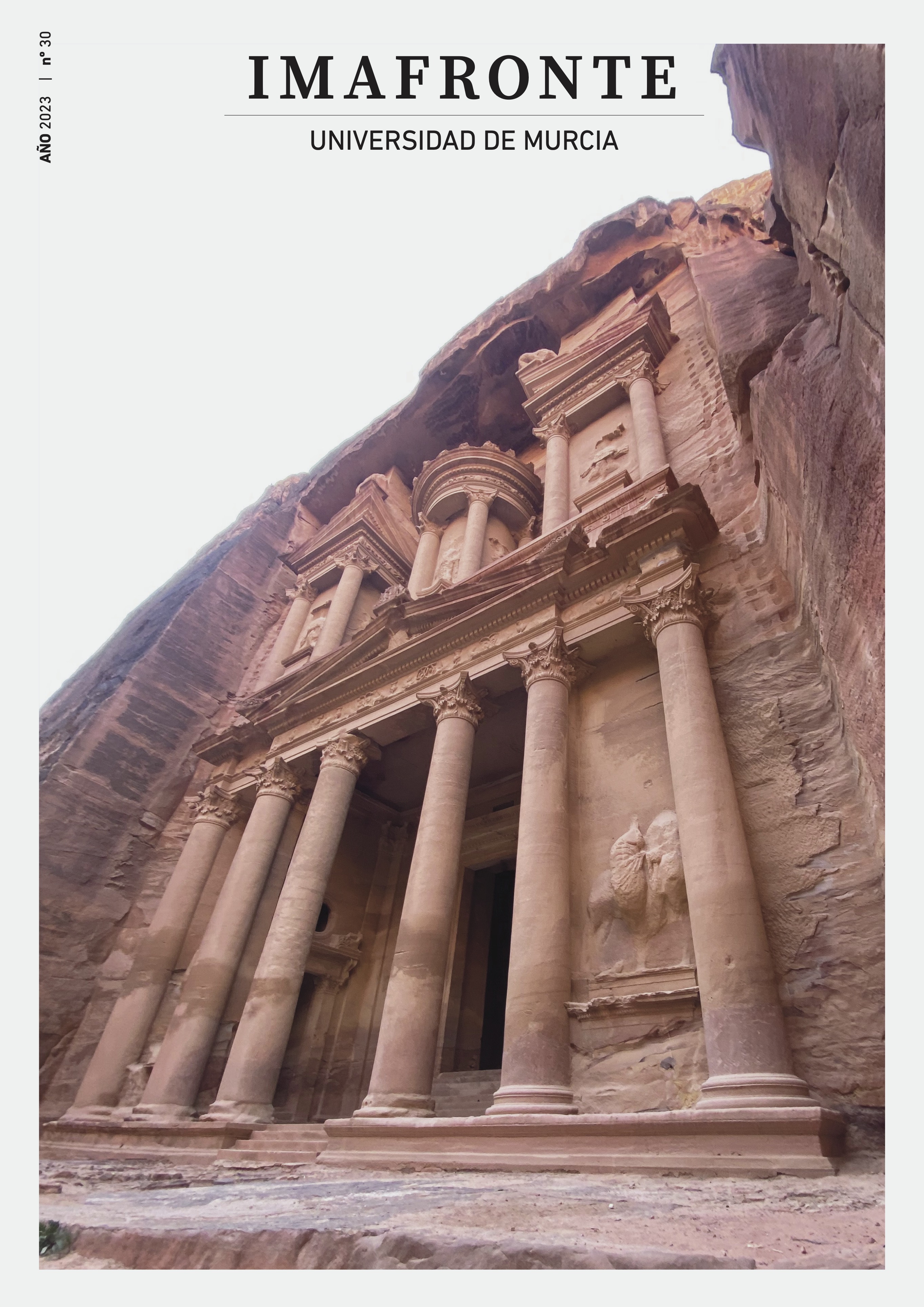Motherhood, heraldry and power. The biblical matriarchs and the capetian queenship in 13th century
Abstract
This article analyses the use of the figure of Saint Anne and other biblical matriarchs for the promotion of Capetian Queens in the 13th century. The most interesting and precedent-setting case is that of Blanche of Castile (1188-1252), who used the great women of Sacred History to justify her position as regent and royal advisor. Her successors, Margaret of Provence (1221 - 1295) and Mary of Brabant (1254 - 1322), would continue the pattern of equating the lineages of the Kings of Israel and the Capet from a female point of view. The origin and evolution of this new image of power, and how motherhood and heraldry became its central themes, will be explored through the study of iconographic programmes, mainly present in their devotional books.
Downloads
-
Abstract972
-
PDF (Español (España))478
-
EPUB (Español (España))219
References
⁃ Adnès, A. (1971). Ademes, dernier grand trouvère. Paris: Picard.
⁃ Allirot, A. H. (2011). Filles du roy de France : Princesses royales, mémoire de saint Louis et conscience dynastique (de 1270 à la fin du XIVe siècle). Turnhout: Brepols.
⁃ Alliot, A. H. (2012). Blanche de la Cerda, fille de saint Louis, et l’ordre franciscaine. Études Franciscaines, 5, 227 - 239.
⁃ Aurell, M. (2019). Chevalerie lettrée, vie de cour et conduite courtoise. Medioevo Romanzo, 43, 6 - 35.
⁃ Bedos Rezak, B. (1988). Women, seals and power in Medieval Frances, 1150 – 1350. En Erler, M. y Kowaleski, M. (ed.), Women and Power in the Middles Ages. Londres: University of Georgia Press, 61 – 82.
⁃ Bell, S. G. (1988). Medieval Women Books Owners: arbiters of lay piety and ambassadors of culture. En Erler, M. Y Kowaleski, M. (ed.), Women and Power in the Middles Ages. Londres: University of Georgia Press, 149 - 187.
⁃ Bouquet, M. et al. (ed.) (1878). Gesta Ludovici VIII, Francum Regis, Recueil des historiens des Gaules et de la France. Vol. XVII. París: Imprimerie royale.
⁃ Boutaric, E. (1867). Marguerite de Provence, son caractère, son rôle politique. Revue des questions historiques, 3, 417 - 458.
⁃ Branderbarg, T. (1995). Sainte Anne: a holy grandmother and her children”. En Mulder-Bakker, A. (ed.), Sanctity and Motherhood: Essays in holy mothers in the Middle Ages. Nueva York: Garland Publishing, 31 - 68.
⁃ Castiñeiras González, M. A. (2015). La santa Parentela, los dos Santiagos y las tres Marías: una encrucijada de la iconografía medieval. En Rucquoi A. (ed.), Maria y Iacobus en los caminos jacobeos. IX Congreso Internacional de Estudios Jacobeos, 21 – 24 octubre 2015. Santiago de Compostela: Xunta de Galicia, 97 – 141.
⁃ Caviness, M. H. (1993). Patron or Matron? A Capetian bride and a vademecum for her marriage bed?. Speculum, 68-2, 333 – 362.
⁃ Caviness, M. H. (1996). Anchoress, Abbes and Queen: Donors and patrons or intercessors and Matrons?. En McCash, J. H. (ed.), The Cultural Patronage of Medieval Woman. Londres: University of Georgia Press, 105 – 154.
⁃ Deshman, R. (1980). The Exalted Servant: the ruler theology of the prayerbook of Charles the Bald. Viator, 2, 385 - 432.
⁃ Dubost, J. F. (2009). Marie de Médicis: la reine dévoilée. París: Payot.
⁃ Field, S. (2006). Isabelle of France: capetian sanctity and franciscan identity in the thirteenth century. Notre dame ind.: Notre Dame University Press.
⁃ Field, S. (2007). The Speculum Anime to Mirror de l’Âme: the origins of vernacular advice literature in the capetian court. Mediaeval Studies, 69, 59 - 110.
⁃ Giannini, G. (2019). De Sainte Anne qui eut trois barons: le Trinubium Annae entre marges et blancs. Romania 137, 257 - 276.
⁃ Grant, L. (2010). Representing Dynasty: the transept windows at Chartres Cathedral. En Maxwell, R. (ed.), Representing History, 900 – 1300: Art, Music, History. University Park Pa.: Pennsylvania University Press, 109 – 114.
⁃ Grant, L. (2016). Blanche of Castile, Queen of France: power, religion and culture in thirteenth century. New Haven: Yale University Press.
⁃ Grant, L. (2017). The Castle of Castille. An image of power or the power of an image. En Collard, F., Lachaud, F. y Scordia, L. (dir.), Images, pouvoirs et norms. Exégèse visuelle de la fin du Moyen Âge (XIIIe – XVe). París: Garnier, 215 – 235.
⁃ Guest, G. B. (2002a). Picturing Women in the First Bible moralisée. En Hourihane, C. (ed.), Insights and Interpretations. Princeton: Princeton University Press, 106 – 130.
⁃ Guest, G. B. (2002b). The people demand a King: visualizing monarchy in the Psalter of Louis IX. Studies In Iconography, 23, 1 - 27.
⁃ Hamilton, T. C. (2003). Queenship and Kinship in the French Bible Moralisée: The Example of Blanche of Castile and Vienna ÖNB 2554. En Nolan, K. (ed.), Capetian Women. Nueva York: Palgrave Macmillan, 177 – 208.
⁃ Hamilton, T. C. (2019). Pleasure and politics at the Court of France. The Artistic Patronage of Queen Marie of Brabant (1260 – 1321), Turnhout: Brepols.
⁃ Holiday, J. (1994). The Education of Jeanne d’Evreux: Personal Piety and Dynastic Salvation in Her Book of Hours and Cloisters, Art History, 17- 4, 585 - 610.
⁃ Jordan, A. (2002). Visualising Kingship in the Windows of the Saint Chapelle. Turnhout: Brepols.
⁃ Jordan, W. C. (1980). The Psalter of Saint Louis (BN MS lat. 10525): the program of the Seventy-Eight Full-Page Illustrations. En Mayo, P. C. (ed.), The Middle Ages. Binghamton: Center for Medieval and Renaissance Studies, 65 - 85.
⁃ Hudson, E. S. (2002). The Psalter of Blanche of Castille: picturing queenly power in thirteenth-century France. Tesis Doctoral, University of North California.
⁃ Kermina, F. (2010). Marie de Médicis: reine, régente et rebelle. París: Perrin.
⁃ Langlois, C. V. (1885). Le Règne de Philipe III, le Hardi. París: Hachette.
⁃ Le Goff, J.(1996). Saint Louis. París: Gallimard.
⁃ Le Sacré Royal à l’époque de Saint Louis. París, Gallimard, 2001.
⁃ Lewis, A. W. (1982). Royal Succession in Capetian France: Studies on Familial Order and the State. Londres: Harvard University Press.
⁃ Lord, K. L. (2008). Guibert de Tournai’s Eruditio Regum et Principum and Louis IX of France. Tesis de Máster, University of Colorado.
⁃ Lowden, J. (2000). Making of the Bibles moralisées, vol. 1. University Park, PA: Pennsylvania State University Press.
⁃ Martínez Ruipérez, A. (2019). The moral compass and mortal slumber: divine and human reason in the Biblés Moralisées. Journal of the Warburg and Courtauld Institutes, LXXXI, 1 - 34.
⁃ Martínez Ruipérez A. (2020). ‘La sagesse de ce monde est folie auprès de Dieu’. Sagesse divine et connaissance humaine dans les Bibles Moralisées. Revue de l’Art, 207, 14 - 25.
⁃ Martínez Ruipérez, A. (2021). Homo insipiens: negando a Dios en el siglo XIII. Goya, 375, 95 - 111.
⁃ McCannon, A. E. (2003). Two capetian queens as the foreground for an aristocrat’s anxiety in the Vie de Saint Louis”. En Nolan, K. (ed.), Capetian Women. Nueva York: Palgrave Macmillan, 163 - 176.
⁃ McCracken, P. (1993). The Body Politic and the Queen’s Adulterous Body in French Romance. En Lomperis, L. y Stanbury, S. (ed.), Feminist Approaches to the Body in Medieval Literature. Filadelfia: University of Pennsylvania Press, 38 – 64.
⁃ Reiffengerb, F. (ed.) (1836 - 1838). Philippe Mousquet. Chronique rimée, vol. 2. Bruselas: M. Hayez.
⁃ Nixon, V. (2004). Mary’s Mother: Saint Anne in late Medieval Europe. University Park: Penn State Press.
⁃ O’Connell, D. (ed.) (1972). The Teachings of Saint Louis: a critical text. Chapel Hill: University of California Press.
⁃ Parsons, J. C. (1994). Family, Sex, and Power: The Rhythms of Medieval Queenship. En Parsons, J. C. (ed.), Medieval Queenship. Nueva York: St. Martin’s, 1 - 11.
⁃ Perkinson, S. (2009). The likeness of the King: a prehistory of portraiture in late medieval France. Chicacho, Chicago University Press.
⁃ Riant, C. P (ed.) (2004). Exuviae Sacrae Constantinopolitanae, vol. 1. París: Éditions du Comité des Travaux Historiques et Scientifiques.
⁃ Ruiz Doménec, J. E. (1999). Les souvenirs croisés de Blanche de Castille”. Cahiers de Civilisation Médiévale, 165, 39 - 54.
⁃ Runciman, S. (1994). A history of the Crusades, volume III : the kingdom of Acre and the later Crusades. Londres: Folio Society.
⁃ Sand, A. (2014). Vision, devotion, and self-representation in Late Medieval Art. Nueva York: Cambridge University Press.
⁃ Nielen, M. A. (ed.) (2011). Sceaux des reines: corpus des sceaux français du Moyen Âge, III, Les Sceaux des reines et des enfants de France. París: Archives de France, 2011.
⁃ Schmitt, J.C. (1990). La Raison des gestes dans l'Occident médiéval. París: Gallimard.
⁃ Schowalter, K. S. (2005). Capetian Women and their books: Art, Ideology and Dynastic Continuity in Medieval France. Tesis Doctoral, Johns Hopkins University.
⁃ Shadis, M. (1996). Piety, politics and power: the patronage of Leonor of England and fer daughters Berenguela of Leon and Blanche of Castile. En McCash, J. H. (ed.). The Cultural Patronage of Medieval Woman. Londres: University of Georgia Press, 202 – 227.
⁃ Shadis, M. (2003). Blanche of Castile and Facinger’s ‘Medieval Quenship’: reassessing the argument. En Nolan, K. (ed.), Capetian Women. Nueva York: Palgrave Macmillan, 137 – 161.
⁃ Sheingorn, P. (1990). Appropriating the Holy Kinship. Gender and Family History. En Ashley, K. y Sheingorn, P. (ed.), Interpreting Cultural Symbols. Sainte Anne in Late Medieval Society. Londres: University Georgia Press, 169 – 198.
⁃ Toilet, M. A. Et al. (eds) (1863 - 1909). Layettes du Trésor de Chartres, vol. II. París: H. Plon.
⁃ Vann, T. M. (2011). ‘Our father has won a great victory’: the authorship of Berenguela’s account of the battle of Las Navas de Tolosa, 1212. Journal of Iberian Studies, 3- 1, 72 - 92.
⁃ Vergara Ciordia, J. (2012). La educación de El de eruditione filiorum nobilium de Vicente de Beauvais. Educación XXI, 15- 2, 73 - 91.
⁃ Weiss, D. H. (1993). Biblical History and Medieval Historiography: Rationalizing Strategies in Crusader Art. Speculum, 108 - 4, 710 – 737.
⁃ Wirth, J. (2003). Sainte Anne est une sorcière et autres essais. Ginebra: Droz.
Copyright (c) 2023 Fuensanta Murcia Nicolas

This work is licensed under a Creative Commons Attribution-ShareAlike 4.0 International License.
1. The authors non-exclusively assign the exploitation rights (reproduction, distribution, communication and transformation) to the magazine.
2. The works published in this magazine are subject to the Attribution-ShareAlike 4.0 International license (CC By SA 4.0). Therefore, they can be copied, used, disseminated, transmitted and publicly displayed, provided that:
i) the authorship and the original source of its publication (journal, editorial and URL of the work) are cited, thus allowing its recognition.
ii) it is allowed to remix, transform or create from the material while maintaining the same license as the original.

3. Self-archiving conditions. Authors are allowed and encouraged to electronically disseminate the pre-print (version before being evaluated) and/or post-print (version evaluated and accepted for publication) versions of their works before publication, as it favors their publication. Earlier circulation and diffusion and with it a possible increase in its citation and reach among the academic community. Color RoMEO: verde.






















